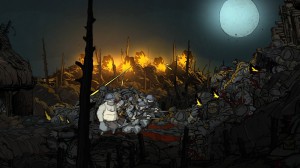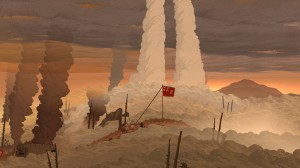Something that I’ve written significantly about recently is the glorification of the Second World War in video games. Games like Call of Duty 2 attempt to portray the war with a sense of realism but the final product often ends up muddled with ever-to-common tropes of heroism and sacrifice with no deeper meaning. The Second World War video game relies on these themes because that is how the Western world remembers this war. Remembrance Day ceremonies in Canada are reinforced with video and commentary of the brave boys that stormed the beaches and helped liberate Europe from the oppression of the evil Nazis. This narrative fits the unfortunately too-often simple storyline that video games follow. Because it is so easy to follow this narrative, the Second World War has been overrepresented in video games while other 20th century conflicts like the First World War has been largely ignored by the medium.
Unlike the Second World War, the Great War has no obvious villain. There is no clear reason for the conflict, as even 100 years later historians still debate the blame of the conflict. In the words of Ben “Yahtzee” Croshaw in his Zero Punctuation review of Valiant Hearts: “Valiant Hearts is set in the First World War, rarely touched by popular culture for lacking the clean us vs. bastards fairy tale narrative of its sequel. World War I was just Europe being such a flustercuck of grudges and alliances that when Serbia turned the little crank of Austria-Hungary it set off the whole mousetrap machine of alliances and by the time the little plastic man landed in the pool, everyone was fighting everyone else.” 16 million people died in the Great War and yet a century later we are left with no proper explanation for why.
The most recent attempt at covering the 1914-1918 conflict is Ubisoft Montpellier’s Valiant Hearts: The Great War. Valiant Hearts is made from Ubisoft’s new game design engine UbiArt Framework, which gives the game a unique art style not found in any other game set in war. However, this cartoon gameplay does not playdown the reality of the First World War.

Very early on the player controls a French soldier, Emile, as his unit is wiped out all around and he himself is wounded and captured as a prisoner of war. At the start of the charge, the mood is upbeat but slowly but surely the scene of French soldiers charging alongside Emile are replaced with dead bodies. Once captured, Emile is forced to cook and clean for the German soldiers only to watch as the base his is held prisoner at is destroyed by a British artillery barrage.
For the most part, this is how the player experiences the Great War in Valiant Hearts. Not as a triumphant warrior but as individuals forced to come to face with the death, wounds, disease, civilian casualties and much more. Other unsettling experiences that the player finds themselves in include amputating a soldier’s arm with a saw, watching soldiers and civilians die from chlorine gas exposure and using a pile of corpses as cover from German machine gun fire. One particular moment that stuck out for me was a moment set at Vauquois in underground warfare. After becoming trapped underground, Emile saves a German soldier stuck under rubble. The German and Emile find their way out of the tunnel and the German soldier helps Emile escape. Later, Emilie helps the French plant TNT underneath the German tunnel system before blowing it up and killing the Germans trapped including the one who aided Emile earlier.

By the end of Valiant Hearts, the player has no clearer understanding of why the Great War happened. What is meant to be shown in this game is the horror, uncertainty, and confusion of the conflict. Characters in the game fight on both sides of the trenches and sometimes that the enemy is not who is across no mans land but rather the commanders within your own ranks. The game is not without flaws. Sometimes Valiant Hearts is guilty of falling into habits of other historical war games by returning to battles of great glory. As a Canadian, I found myself rolling my eyes at the end of the Vimy Ridge scene, where as Freddie and two Canadian soldiers raise the Canadian flag at the top of the ridge, the clouds in the background create two vertical columns designed to look like the Vimy memorial in France. However, what Valiant Hearts is representative of is a new way of recreating past wars without entirely falling victim to the First Person Shooter glorification. It shows that games can recreate war in all its barbarity.

2 Comments